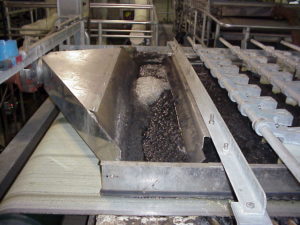The Sludge Report: What Happens After Treatment?
June 19, 2019If you’re a regular visitor, you’ll know we’ve been doing a series of posts explaining how wastewater is treated. In our last post, we talked about why it needs to be treated — and what happens when it’s not.
Today, we’re going to discuss one of the byproducts of treatment: sewage sludge.
Sewage sludge is a foul smelling, highly infectious, concentrated mixture of unspeakables that society has flushed down the drain. Yet believe it or not, once treated, it’s a valuable source of energy and plant nutrients.
Every person in the United States is responsible in some shape or form for the production of sewage sludge. Every product you purchase has, at some point, water tied to its creation, and therefore contributes to the production of wastewater residuals: The materials created/left over after wastewater treatment.
Even if you don’t have public sewer service and use an on-lot septic system instead, where do you think the truck takes the muck after your tanks have been pumped every three years? Sludge must be properly treated before disposal. And unfortunately, EVERY method of disposal practiced today has some type of environmental impact:
- Incineration: Contributes to production of greenhouse gases/global warming; creates exhaust gases that contain dioxins, other carcinogens, and heavy metals; ash residue is classified as a hazardous waste.
- Landfill Disposal: Leachate must be collected and properly disposed of; contamination of groundwater with leachate occurs; requires huge swaths of land dedicated to burying garbage and sludge.
- Land Application: Creates microconstituents (also called micropollutants) — traces of chemicals, pharmaceuticals, metals and more; contains pathogenic microorganisms; can lead to heavy metal accumulation.
In short, there’s no perfect solution for the disposal of wastewater residuals. Wastewater professionals do the best they can with the tools that science and equipment manufacturers have provided within the budget allocated by elected officials.
Outstanding in the field
At the Kline’s Island Wastewater Treatment Plant, we rely on land application. The 44 million gallons of residuals collected from the treatment processes are managed through a three-step process: 1) anaerobic digestion stabilization 2) belt filter press dewatering 3) biosolids application to farm fields as a soil amenity. All sludge is tested first to ensure it meets (and exceeds) EPA guidelines.
We find this method offers a number of environmental benefits that help, in part, to offset sludge’s negative effects. Here’s how it works:
The sludge collected within the 17 settling tanks constructed at the Kline’s Island facility must first be stabilized so it can be disposed of in a safe and environmentally friendly manner. This is accomplished by the anaerobic digesters.
We covered the anaerobic digestion process in an earlier post, but here’s a recap: Bacteria in an oxygen-free environment is used to convert solids in the sludge to methane, carbon dioxide and water. Pathogens are reduced, the volume of digested material requiring disposal is significantly reduced, and the “biosolids” end product is a soil amenity than can be applied to farm fields.
Creating Energy
Another benefit of this process: A significant part of the energy needed to run the treatment plant is supplied by firing the methane generated by the anaerobic digesters during the conversion of sewage sludge to biosolids. Globally, wastewater treatment is responsible for about 1.6% of total greenhouse gas emissions; use of this digestion byproduct helps reduce that environmental impact.

After residing in the primary digesters for about 20 days, the biosolids flow by gravity to
the secondary digester, where they stay for about 10 days. The biosolids settle on the sloped floor of the secondary tank, where they are eventually removed for dewatering on the Belt Filter Presses. Belt Filter Presses use a combination of pressure and gravity to remove moisture. After they’ve been dewatered, the remaining biosolid “cakes” are loaded into dump body trailers and hauled to farm fields.
According to the EPA, about half of the biosolids generated in the United States are recycled. Biosolids provide farmers with about $100 per acre worth of natural fertilizer, which includes many essential nutrients not typically found in chemical fertilizers.
Biosolids are rich in nitrogen and phosphorus, two elements essential for crop growth, and biosolids also contain micronutrients required by plants such as copper, boron, molybdenum, zinc and iron. Biosolids help improve, replenish and maintain healthy soil by adding important nutrients, boosting soil water-holding capacity and reducing topsoil runoff, all of which serve to increase crop yields.
The largest component of biosolids is organic matter, which acts as a soil conditioner to promote necessary bacterial activity, loosens clay and improves the consistency of sandy soils. Biosolids promote dense, healthy root growth, allowing plants to take up nutrients better.
The result is higher crop productivity than is possible with equivalent amounts of chemical fertilizers — and land-applied biosolids are less likely to cause nutrient pollution than are animal manures or chemical fertilizers.
For the rest in our Behind the Scenes series, please see:
Wastewater Treatment Starts with Screening Out Items That Don’t Belong
Why Does Wastewater Need to be Treated?
Pump it Up: The Role of LCA’s Giant Wastewater Movers
Clean and Green: How Waste is Turned into Energy at Kline’s Island
Sludge 101: How Solids Are Removed From Wastewater
How Is Liquid Waste Treated? It’s All About Biology
Tertiary Nitrification: How Ammonia Is Removed From Wastewater
Disinfection and Testing — the Final Steps in Wastewater Treatment